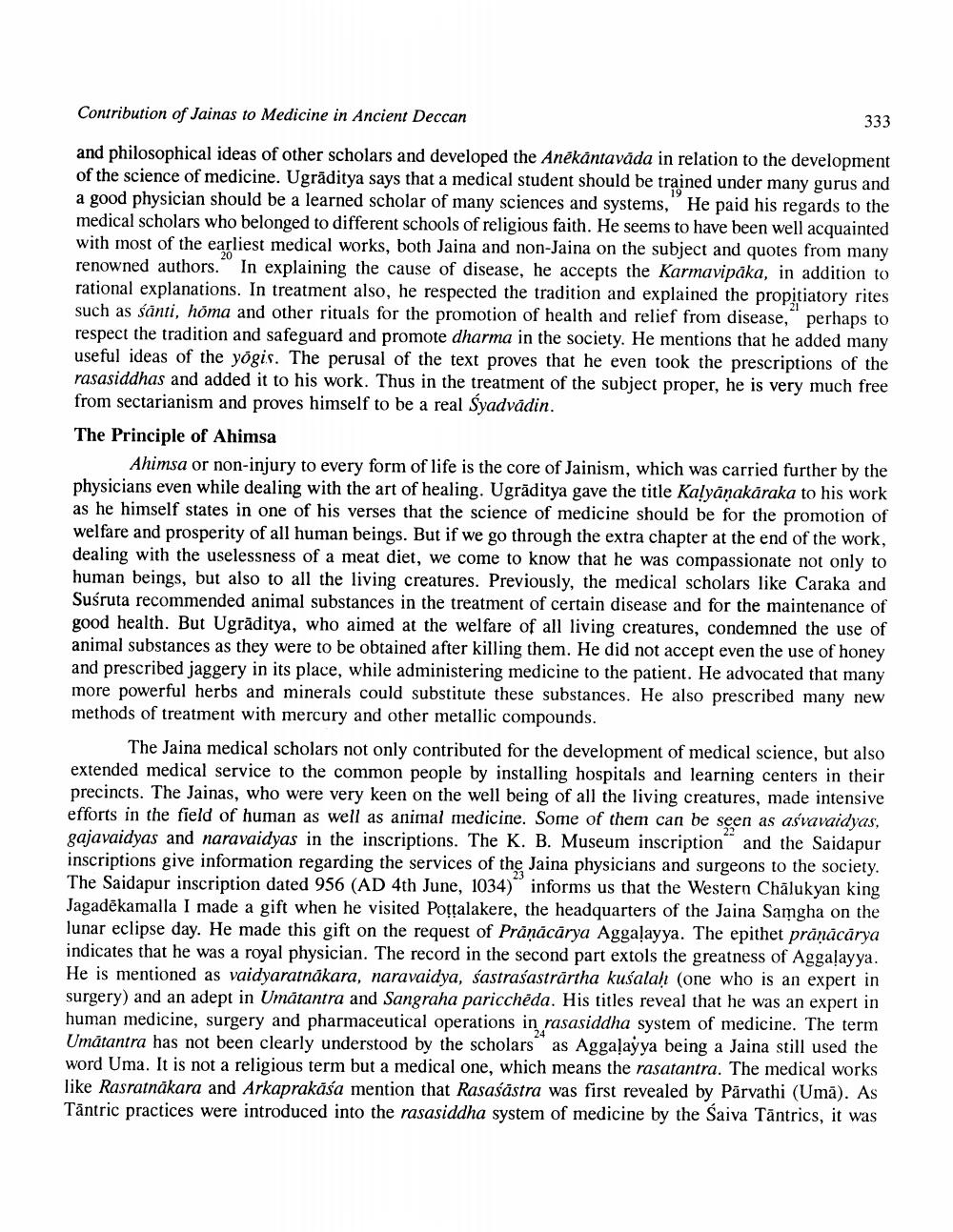________________
Contribution of Jainas to Medicine in Ancient Deccan
333
and philosophical ideas of other scholars and developed the Anēkantavāda in relation to the development of the science of medicine. Ugrāditya says that a medical student should be trained under many gurus and a good physician should be a learned scholar of many sciences and systems," He paid his regards to the medical scholars who belonged to different schools of religious faith. He seems to have been well acquainted with most of the earliest medical works, both Jaina and non-Jaina on the subject and quotes from many renowned authors." In explaining the cause of disease, he accepts the Karmavipäka, in addition to rational explanations. In treatment also, he respected the tradition and explained the propitiatory rites such as sānti, höma and other rituals for the promotion of health and relief from disease, perhaps to respect the tradition and safeguard and promote dharma in the society. He mentions that he added many useful ideas of the yogis. The perusal of the text proves that he even took the prescriptions of the rasasiddhas and added it to his work. Thus in the treatment of the subject proper, he is very much free from sectarianism and proves himself to be a real siyadvädin. The Principle of Ahimsa
Ahimsa or non-injury to every form of life is the core of Jainism, which was carried further by the physicians even while dealing with the art of healing. Ugrāditya gave the title Kalyāņakāraka to his work as he himself states in one of his verses that the science of medicine should be for the promotion of welfare and prosperity of all human beings. But if we go through the extra chapter at the end of the work, dealing with the uselessness of a meat diet, we come to know that he was compassionate not only to human beings, but also to all the living creatures. Previously, the medical scholars like Caraka and Susruta recommended animal substances in the treatment of certain disease and for the maintenance of good health. But Ugrāditya, who aimed at the welfare of all living creatures, condemned the use of animal substances as they were to be obtained after killing them. He did not accept even the use of honey and prescribed jaggery in its place, while administering medicine to the patient. He advocated that many more powerful herbs and minerals could substitute these substances. He also prescribed many new methods of treatment with mercury and other metallic compounds.
The Jaina medical scholars not only contributed for the development of medical science, but also extended medical service to the common people by installing hospitals and learning centers in their precincts. The Jainas, who were very keen on the well being of all the living creatures, made intensive efforts in the field of human as well as animal medicine. Some of them can be seen as asvavaidyas, gajavaidyas and naravaidyas in the inscriptions. The K. B. Museum inscription and the Saidapur inscriptions give information regarding the services of the Jaina physicians and surgeons to the society. The Saidapur inscription dated 956 (AD 4th June, 1034) informs us that the Western Chālukyan king Jagadēkamalla I made a gift when he visited Pottalakere, the headquarters of the Jaina Samgha on the lunar eclipse day. He made this gift on the request of Prāņācārya Aggaļayya. The epithet prāṇācārya indicates that he was a royal physician. The record in the second part extols the greatness of Aggalayya. He is mentioned as vaidyaratnākara, naravaidya, sastraśastrărtha kuśalah (one who is an expert in surgery) and an adept in Umātantra and Sangraha paricchēda. His titles reveal that he was an expert in human medicine, surgery and pharmaceutical operations in rasasiddha system of medicine. The term Umātantra has not been clearly understood by the scholars as Aggaļayya being a Jaina still used the word Uma. It is not a religious term but a medical one, which means the rasatantra. The medical works like Rasratnākara and Arkaprakāśa mention that Rasaśāstra was first revealed by Pārvathi (Umā). As Tântric practices were introduced into the rasasiddha system of medicine by the Saiva Tāntrics, it was




